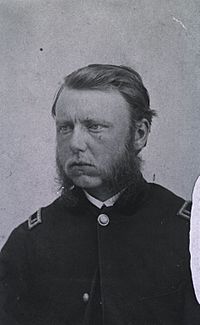Washington Matthews facts for kids
Quick facts for kids
Washington Matthews
|
|
|---|---|

Photo credit: National Library of Medicine
|
|
| Born |
Washington Matthews
June 17, 1843 Killiney, near Dublin, Ireland
|
| Died | March 2, 1905 (aged 61) |
| Alma mater | University of Iowa |
| Known for | Ethnography of the Native American peoples |
Washington Matthews (June 17, 1843 – March 2, 1905) was an important figure who served as a doctor in the United States Army. He was also an ethnographer, meaning he studied different cultures, and a linguist, someone who studies languages. He is best known for his deep studies of Native American peoples, especially the Navajo.
Contents
Early Life and Learning
Matthews was born in 1843 in Killiney, a place near Dublin, Ireland. His parents were Nicolas Blayney Matthews and Anna Burke Matthews. Sadly, his mother passed away a few years after he was born. His father then moved with Washington and his brother to the United States.
He grew up in the states of Wisconsin and Iowa. His father, who was also a medical doctor, began teaching his son about medicine. Washington went on to graduate from the University of Iowa in 1864 with a degree in medicine.
At that time, the American Civil War was happening. This was a big war fought between different parts of the United States. Right after graduating, Matthews volunteered to join the Union Army. His first job was as a doctor at Rock Island Barracks in Illinois. There, he took care of soldiers who were prisoners from the Confederate side.
Exploring the American West
In 1865, Matthews was sent to Fort Union in what is now Montana. It was here that he became very interested in Native American peoples and their languages. He then served at several forts in the Dakota Territory until 1872. These forts included Fort Berthold, Fort Stevenson, Fort Rice, and Fort Buford. In 1867, he was part of an important trip led by General Alfred H. Terry in the Dakota Territory.
While he was at the Fort Berthold, he learned to speak the Hidatsa language very well. He wrote many books and papers about the Hidatsa culture and language. These included a description of their culture, a grammar book, and a list of words from the Hidatsa language. He also wrote a detailed study about the Hidatsa people. He also described, though less completely, the related Mandan and Arikara peoples and their languages.
Later, in 1877, he joined a trip against the Nez Perce people. In 1878, he was part of another trip against the Bannock. While working at a prison on Alcatraz Island in San Francisco Bay, Matthews studied the Modoc language.
Research at the Museum
From 1884 to 1890, Matthews worked at the Army Medical Museum in Washington, DC. During this time, he did a lot of research. He wrote several papers about physical anthropology. This is the study of human physical features and how they vary. He focused on measuring skulls (craniometry) and other body parts (anthropometry).
John Wesley Powell from the Smithsonian Institution suggested that Matthews be sent to Fort Wingate. This fort was near what is now Gallup, New Mexico. It was there that Matthews met the Navajo people. They would become the main focus of his most famous work.
His studies of the Navajo helped to correct wrong ideas people had about their culture. Before Matthews, some people thought Navajo culture was simple. They believed the Navajo had no stories or poetry, and their songs were just "grunts."
But Dr. Matthews found that the Navajo had many, many stories and legends. He discovered they had a complex religion with deep meanings and symbols. He also found countless prayers and songs for every part of life. These songs were full of beautiful poetic images, just like English poetry. They were passed down from parents to children through many generations.
Matthews learned a lot by being welcomed into some Navajo ceremonies. His work showed the world how rich and complex the Navajo culture truly was.
|

